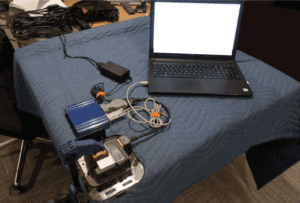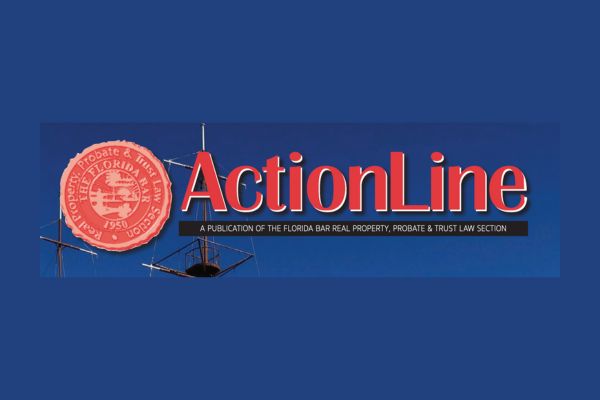Think Inside the Box
Black box data retrieval after a serious accident—it’s not just for commercial airplanes anymore.
I WAS IN MY OFFICE when a call came through from a potential client who had recently left the hospital after a terrible car accident. She had been driving in a rural area near her home and had a T-bone collision with a pickup at a dirt-road intersection. Both vehicles were badly damaged; she and the other driver each sustained serious injuries.
Because of a mild traumatic brain injury caused by the crash, she couldn’t remember anything about it. The last thing she recalled was approaching the stop sign at the intersection. She was calling me not to bring a claim against the other driver, but because she had been notified that the driver had hired an attorney who was making a claim against not only her insurance policy but her personal assets. “I know I had the stop sign,” she told me, “but I drive that road every day, and there is no way I would have just blown through the intersection.”
Had I taken this call a decade ago, there would likely have been nothing I could do to help. An unwitnessed accident on a rural road of which my client remembered nothing and the other driver had the right of way would have been a steep evidentiary hill to climb. We might have been able to hire an accident reconstructionist for $10,000 or $15,000 in the hope of estimating the other driver’s speed as excessive, but it’s highly unlikely that would have overcome the fact that he had the right of way.
Thankfully, though, nearly every noncommercial vehicle now stores extensive “black box” data that can be used to prove previously unwinnable auto-collision cases. For this client, that data was key not only to protecting her personal assets but ultimately to making a successful recovery against the other driver’s insurance company on her behalf.
A History of Black Box Data
Most people know that commercial airplanes are equipped with virtually indestructible black box flight recorders that gather information from flight computers. After a jet crash, data retrieved from the black box plays a critical role in definitively determining the cause. Much less well known is that cars now employ the same technology.
The concept of recording crash data in motor vehicles is not new. Starting in the 1990s, the major American automakers began installing rudimentary data recorders in their vehicles as an internal mechanism to see how they performed in a crash. The data recorded was not uniform, though, and it was difficult to access.
In the early 2000s, the National Highway Traffic Safety Administration (NHTSA) began collecting black box information, and since 2014, every new vehicle has been outfitted with a black box whose data must be retrievable via computer download. If any such car is involved in a crash, the black box stores information from the 20 seconds prior to impact: vehicle speed, throttle position, airbag deployment times, engine speed, steering angles, whether the driver applied the brakes and whether those inside were wearing seat belts.
For purposes of reconstructing an accident, this data can be more accurate and more valuable than any eyewitness testimony. But it’s useful only if it’s retrieved in the first place. Far too often, unrepresented victims (and even some attorneys) miss their chance to access the data. There are steps that can force the driver at fault or the insurance company to preserve the black box, but if they aren’t taken soon after the accident, access to the information may be lost forever.
Preserving and Accessing the Black Box
Any data preserved on a vehicle’s black box is theoretically available until the vehicle is destroyed or the black box removed. Downloading the information is not difficult for a trained professional, and the modest cost of doing so is typically advanced by a client’s attorney. That doesn’t mean that the insurance adjuster handling the claim will automatically preserve the black box or will voluntarily agree to permit access to the at-fault driver’s vehicle. Some might maintain that the data is the rightful property of the vehicle’s owner and refuse to make it available on privacy grounds. Indeed, numerous states have made it illegal to download black box data without the owner’s permission, so withholding access from third parties may be allowed initially.
This might work as a temporary barrier, but the privacy argument will likely fail if challenged in court by an attorney representing a client in a contested liability case. Because such challenges take time and the vehicle in question could be long gone before a suit is initiated, a timely letter demanding that all data be preserved until it can be downloaded is one of the first steps an attorney ought to consider after being retained. This kind of letter often lead to direct data access—and can also perfect a later claim for destruction of evidence if the preservation request is disregarded and the vehicle sold or destroyed.
Even if a non-totaled car has been sold, it might not be too late to get the data. Title research done online can help locate the car’s current owner, who now owns the black box and any data it holds, even if it was recorded before he or she bought the car. In such a case, the current owner may agree to allow an expert to download the data from before he or she took title.
Assuming a client retains a knowledgeable attorney early, the more typical scenario is that every vehicle involved in an accident will be available for a sufficient time to conduct a download. An expert can easily plug into the black box and download the data, which is then translated into a program that outlines the key information from the crash itself, as well as the preceding 20 seconds.


While we can never know for sure why he took such aggressive and perilous actions, the data clearly demonstrated an intent to cause a crash that could easily have been avoided. That’s all it took to protect my client’s previously vulnerable assets and recover the full value of insurance coverage on her behalf. It also gave her peace of mind knowing she hadn’t been careless in a way that brought harm to someone else.
Anyone involved in a car accident resulting in injuries should be aware of the extensive data stored on an automobile’s black box and take steps to make sure it’s preserved. What you find might not be as dramatic as in my client’s case, but it might end up just as critical to proving a case of contested fault.


Carter, David M. “Think Inside the Box.” Best Lawyers, 25 Mar. 2022, pp. 71–75. <https://www.bestlawyers.com/publications/injury-malpractice>








